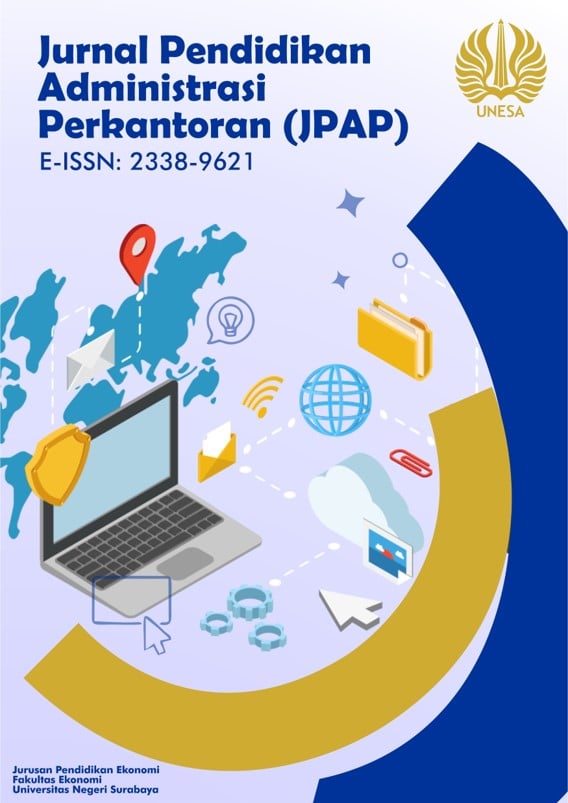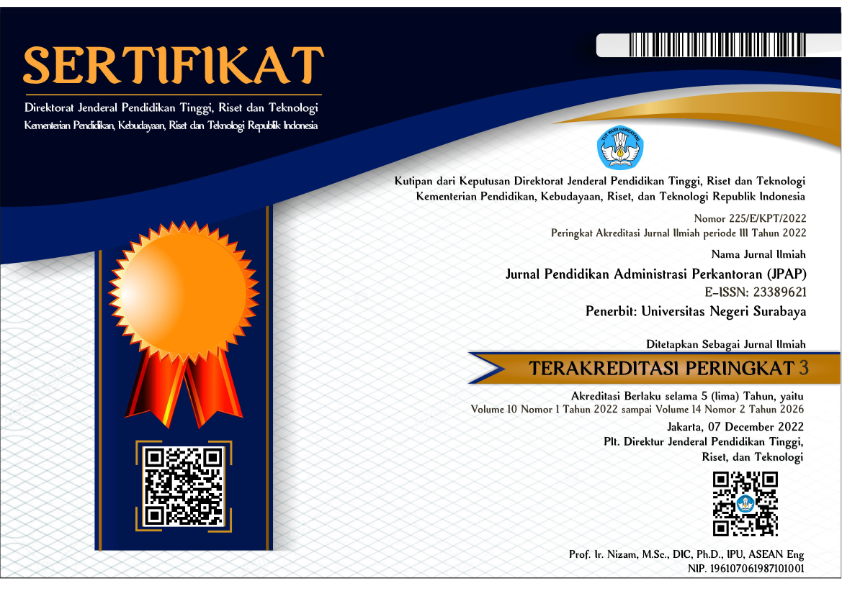Pengaruh Model Pembelajaran Two Stay Two Stray Terhadap Hasil Belajar Siswa pada Mata Pelajaran Administrasi Umum di SMK Ketintang Surabaya
DOI:
https://doi.org/10.26740/jpap.v8n1.p122-135Keywords:
Learning Outcomes, Two Stay Two Stray ModelAbstract
Researchers have a goal in research that is to determine the application of the two stay two stray learning model on student learning outcomes in general administration subjects at SMK Ketintang Surabaya and to determine the effect of the two stay two stray learning model on student learning outcomes in general administration subjects in SMK Ketintang Surabaya. This study uses an experimental research type with an experimental design quaisi in the form of nonequivalent group pretest posttest design. The population in this study used class X OTKP 1, OTKP 2, and OTKP 3 with a total number of 95 students and the sample used was class X OTKP 2 with a total of 30 students as a control class and class X OTKP 3 with a total of 30 students as an experimental class. This study uses data collection techniques such as observation, interviews, tests, and documentation. The data analysis technique uses validity test, reliability test, difficulty level test, differentiation test, homogeneity test, normality test, t test and gaincore. The results of this study showed the average pretest score in the control class was 55, while the experimental class was 58.12. Then the average posttest in the control class was 70.33, while the experimental class was 83.17. Based on the of the t-test result about the posttest score that has been done by researchers that counted 5.693 with a significance level of 0.000. While the ttable can be searched using the ttable distribution with a confidence level of 95% (? = 5%, because the t test is two-sided) with a degree of df 58, so it is known that the ttable is 2.001. Then it can be concluded that tcount (5,693)> ttable (2,001). So it can be concluded that Ha is accepted or there is an influence of two-stay-two-stray learning model on student learning outcomes in general administration subjects at SMK Ketintang Surabaya.
References
Arikunto, S. (2014). Prosedur Penelitian: Suatu Pendekatan Praktik. Jakarta: Rineka Cipta.
Arikunto, S. (2018). Dasar-dasar Evaluasi Pendidikan. Jakarta: Bumi Aksara.
Fathurrohman, M. (2017). Model-model Pembelajaran Inovatif: Alternatif Desain Pembelajaran Yang Menyenangkan. Jogjakarta: Ar-Ruzz Media.
Harahap, K. A., & Surya, E. (2017). Application of Cooperative Learning Model With Type of Two Stay Two Stray to Improve Results of Mathematics Teaching. International Journal of Sciences: Basic and Applied Research (IJSBAR), 33(2), 156165.
Hidayat, T. M., & Muhson, A. (2018). The Impact of Think Pair Share and Two Stay Two Stray Learning Model Towards Learning Outcomes and Cooperation Ability. Dinamika Pendidikan, 13(1), 119129.
Huda, M. (2013). Model-model Pengajaran dan Pembelajaran: Isu-isu Metodis dan Paradigmatis. Yogyakarta: Pustaka Pelajar.
Jihad, A., & Haris, A. (2012). Evaluasi Pembelajaran. Yogyakarta: Multi Pressindo.
Kurniasih, T. (2016). Penerapan Model Pembelajaran Langsung untuk Meningkatkan Hasil Belajar IPA Siswa Kelas I SDN 006 TRI Mulya Jaya. Primary Pendidikan Guru Sekolah Dasar Fakultas Keguruan Dan Ilmu Pendidikan Universitas Riau, 5(3), 275287.
Megayani, & Maulana, I. (2017). Penerapan Model Pembelajaran Kooperatif Tipe Two Stay Two Stray (TSTS) Terhadap Hasil Belajar Siswa Pada Materi Sistem Ekskresi. Bio Education, 2(2), 2734.
Peraturan Pemerintah No. 17 Tahun 2010 Tentang Pengelolaan dan Penyelenggaraan Pendidikan.
Purwanto. (2018). Evaluasi Hasil Belajar. Yogyakarta: Pustaka Pelajar.
Puspasari, D., & Puspasari, D. (2015). Meningkatkan Keterampilan Berkomunikasi Mahasiswa Pendidikan Administrasi Perkantoran Melalui Pembelajaran Two Stay-Two Stray (TS-TS). Porsiding Seminar Nasional PAP œPengembangan Ilmu dan Profesi Administrasi Perkantoran: Peluang dan Tantangan, (September), 1121.
Risdiyanto, R. (2014). Penerapan Pembelajaran Kooperatif dengan Metode Two Stay Two Stray pada materi Pokok Perbaikan Sistem Rem Kelas XI TKR 2 di SMK Antartika 1. JPTM, 03(1), 5055.
Sani, R. A. (2015). Inovasi Pembelajaran. Jakarta: Bumi Aksara.
Siregar, E., & Nara, H. (2015). Teori Belajar dan Pembelajaran. Bogor: Ghalia Indonesia.
Slavin, R. E. (2005). Cooperative Learning Teori, Riset, dan Praktik. Bandung: Nusa Media.
Suprijono, A. (2019). Cooperative Learning Teori dan Aplikasi PAIKEM. Yogyakarta: Pustaka Pelajar.
Wahyuni, I., & Munthe, Y. G. (2014). Pengaruh Model Pembelajaran Kooperatif Tipe Two Stay Two Stray (TSTS) Terhadap Hasil Belajar Siswa Pada Materi Listrik Dinamis Pada Siswa SMA. Jurnal Pendidikan Fisika, 3(1), 17.
Wardana, L. W., Setyani, R., & Harwida, G. (2018). The Implementation of the Two Stay Two Stray (Tsts) Learning Model and Co-Op Co-Op for the Improvement of Students Learning Outcome in the Crafts and Entrepreneurship Subject. Knowledge Social Sciences, 3(3), 140.
Yulianti, R., Muntari, & Haris, M. (2015). Pengaruh Model Pembelajaran Kooperatif Tipe Two Stay Two Stray (TSTS) dengan Pendekatan Brain-Based Learning terhadap hasil belajar Kimia materi Pokok Struktur Atom dan Sistem Periodik Unsur pada siswa Kelas X SMAN 1 Kediri. Pijar MIPA, X(1), 5760.
Yusri, Mantasiah R, & Jufri. (2018). The Use of Two Stay Two Stray Model in English Teaching To Increase StudentS Learning Outcome. Journal of Advanced English Studies, 1(1), 3943.
Zamzam, F. (2015). Developing Speaking Skill of Grade XI Students at SMAN 5 Palu Through Two Stay Two Stray Technique. Bahasantodea, 3(1), 109117.
 Abstract views: 354
,
Abstract views: 354
, PDF Downloads: 749
PDF Downloads: 749










